人教版(2019)选择性必修第一册Unit 2 Look into the future Using Language课件(共17张PPT,内镶嵌视频)
文档属性
| 名称 | 人教版(2019)选择性必修第一册Unit 2 Look into the future Using Language课件(共17张PPT,内镶嵌视频) |
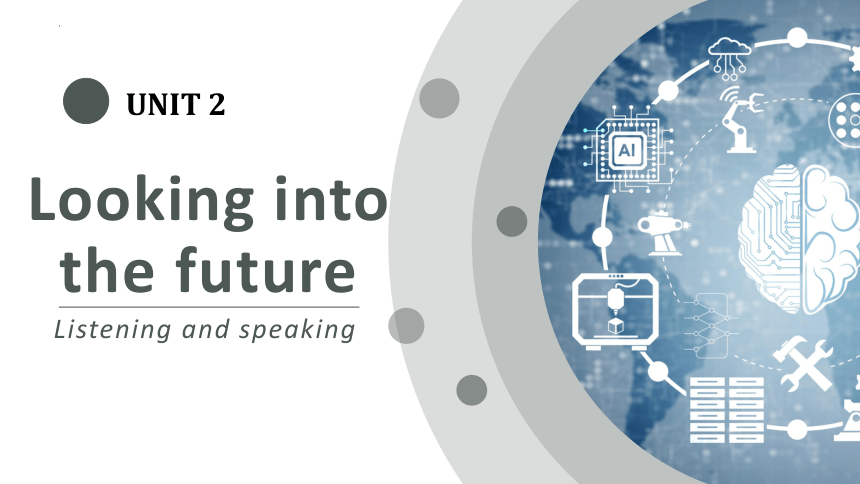
|
|
| 格式 | pptx | ||
| 文件大小 | 24.8MB | ||
| 资源类型 | 教案 | ||
| 版本资源 | 人教版(2019) | ||
| 科目 | 英语 | ||
| 更新时间 | 2024-10-07 18:14:51 | ||
图片预览

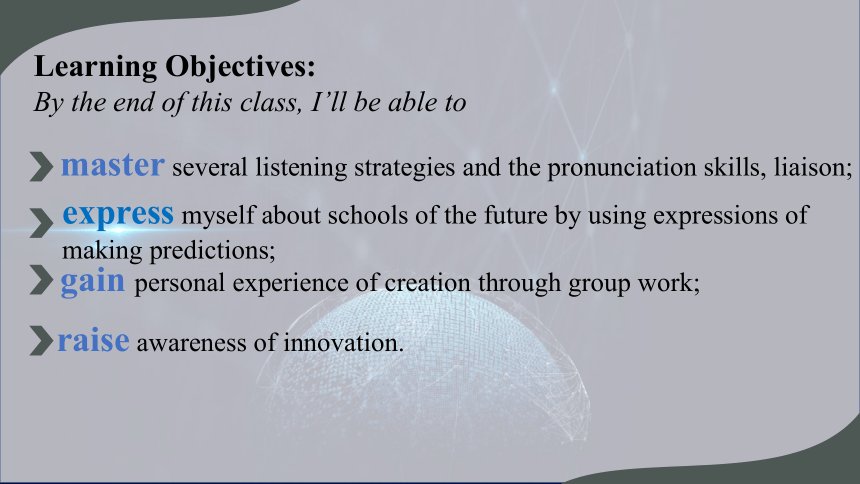
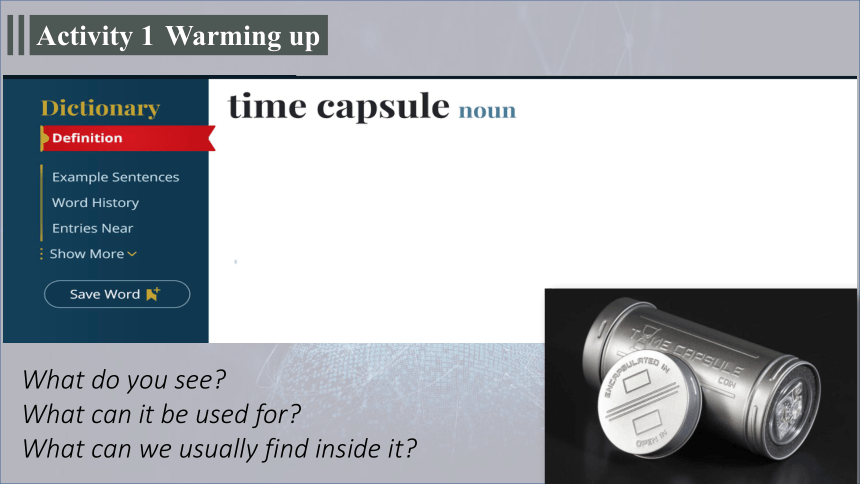
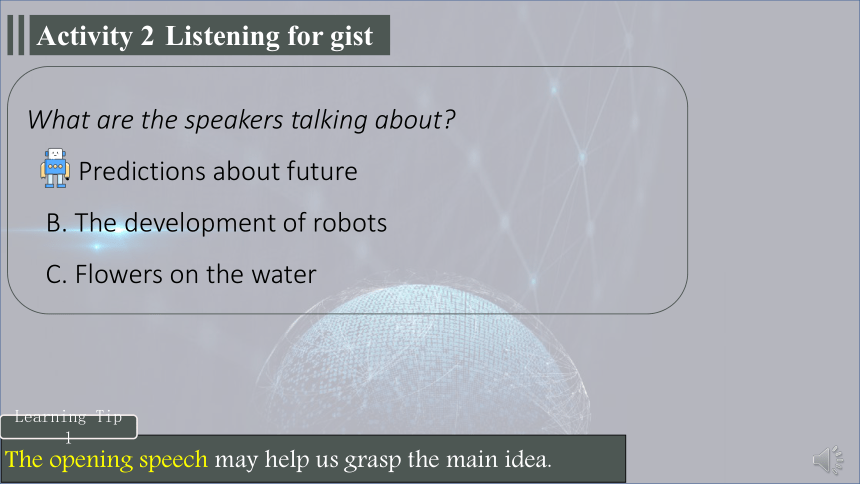

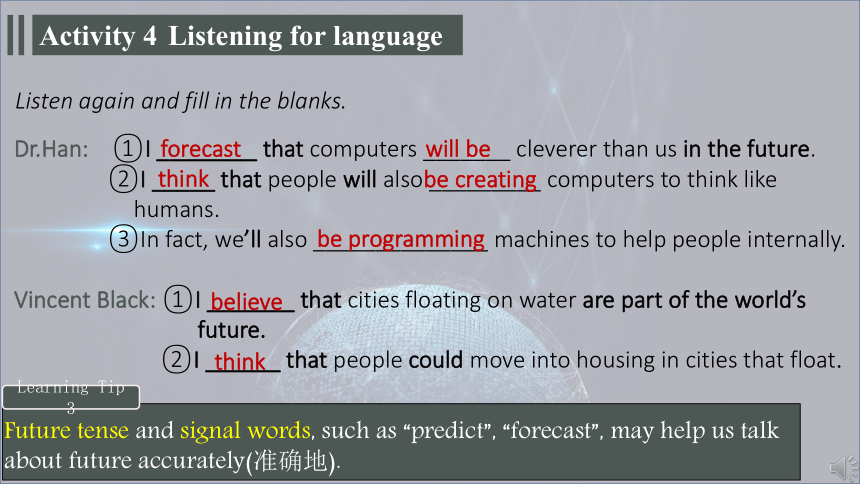
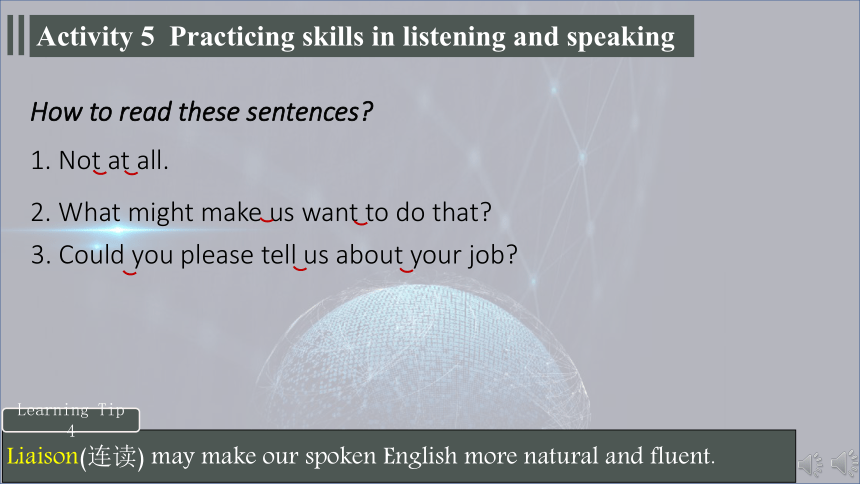
文档简介
(共17张PPT)
Looking into the future
Listening and speaking
UNIT 2
master several listening strategies and the pronunciation skills, liaison;
Learning Objectives:
By the end of this class, I’ll be able to
express myself about schools of the future by using expressions of making predictions;
gain personal experience of creation through group work;
raise awareness of innovation.
Activity 1 Warming up
a container that holds objects meant for people and then buried, so that it can be dug up and studied much later
What do you see
What can it be used for
What can we usually find inside it
What are the speakers talking about
A. Predictions about future
B. The development of robots
C. Flowers on the water
Activity 2 Listening for gist
Learning Tip 1
The opening speech may help us grasp the main idea.
Dr. Han’s prediction Vincent Black’s prediction Structure
Computers will be _______than humans. The sea level will ____ by many meters.
Robots will be programmed to not think in ways that may _____ humans. Nanobots will be _____ inside our bodies. Cities _______ on water will be built.
Our abilities will be _________. People don’t need to ______ away from the sea.
Activity 3 Listening for structure
Listen, fill in the table and analyze the structure.
harm
put
increased
cleverer
rise
floating
move
problems
solutions
results / effects
Learning Tip 2
The structure may help us understand the text better.
Activity 4 Listening for language
Dr.Han: ①I ________ that computers _______ cleverer than us in the future.
②I _____ that people will also _________ computers to think like
humans.
③In fact, we’ll also ______________ machines to help people internally.
Vincent Black: ①I _______ that cities floating on water are part of the world’s
future.
②I ______ that people could move into housing in cities that float.
Listen again and fill in the blanks.
forecast
will be
think
be programming
be creating
believe
think
Learning Tip 3
Future tense and signal words, such as “predict”, “forecast”, may help us talk about future accurately(准确地).
How to read these sentences
1. Not at all.
2. What might make us want to do that
Activity 5 Practicing skills in listening and speaking
3. Could you please tell us about your job
Learning Tip 4
Liaison(连读) may make our spoken English more natural and fluent.
What will schools look like in the future
We think/believe/predict that in the future…
Our prediction is that…
In the (distant) future there will…
We can imagine/forecast…
We doubt/don’t think that…
We will have the opportunity to…
We are going to…
Sample:
I predict that in the future our desks can be
equipped with the HUD.
Sentence patterns of making predictions may help us express ourselves better.
Activity 5 Practicing skills in listening and speaking
Learning Tip 5
Activity 6 Speaking for creative thinking
What will No. 18 Middle School be like in 50 years
Activity 6 Speaking for creative thinking
What will No. 18 Middle School be like in 50 years
Group 1—Group 3: the teaching building
Group 4—Group 6: the canteen
1. Draw the place (sheet A) .
2. Describe the place (sheet B) :
What is it
What is used for
(use expressions of making predictions)
The best way to predict the future is to create it.
Activity 7 Self-assessing
Wonderful Just so-so Not very good
1. master several listening strategies and the pronunciation skills, liaison
2. express myself about schools of the future by using expressions of making predictions
3. gain personal experience of creation through group work
4. raise awareness of innovation
Learning Tip 6
Self-assessment may help us become active learners to be responsible for our learning process.
Now, I am able to
Option 1: Surf the Internet and collect some relevant information about school of the future.
Option 2: Choose one of the 4 places (the school gate, the library, the playground and the office building) to draw and describe it.
Assignment
T
H
A
N
K
S
Looking into the future
Listening and speaking
UNIT 2
master several listening strategies and the pronunciation skills, liaison;
Learning Objectives:
By the end of this class, I’ll be able to
express myself about schools of the future by using expressions of making predictions;
gain personal experience of creation through group work;
raise awareness of innovation.
Activity 1 Warming up
a container that holds objects meant for people and then buried, so that it can be dug up and studied much later
What do you see
What can it be used for
What can we usually find inside it
What are the speakers talking about
A. Predictions about future
B. The development of robots
C. Flowers on the water
Activity 2 Listening for gist
Learning Tip 1
The opening speech may help us grasp the main idea.
Dr. Han’s prediction Vincent Black’s prediction Structure
Computers will be _______than humans. The sea level will ____ by many meters.
Robots will be programmed to not think in ways that may _____ humans. Nanobots will be _____ inside our bodies. Cities _______ on water will be built.
Our abilities will be _________. People don’t need to ______ away from the sea.
Activity 3 Listening for structure
Listen, fill in the table and analyze the structure.
harm
put
increased
cleverer
rise
floating
move
problems
solutions
results / effects
Learning Tip 2
The structure may help us understand the text better.
Activity 4 Listening for language
Dr.Han: ①I ________ that computers _______ cleverer than us in the future.
②I _____ that people will also _________ computers to think like
humans.
③In fact, we’ll also ______________ machines to help people internally.
Vincent Black: ①I _______ that cities floating on water are part of the world’s
future.
②I ______ that people could move into housing in cities that float.
Listen again and fill in the blanks.
forecast
will be
think
be programming
be creating
believe
think
Learning Tip 3
Future tense and signal words, such as “predict”, “forecast”, may help us talk about future accurately(准确地).
How to read these sentences
1. Not at all.
2. What might make us want to do that
Activity 5 Practicing skills in listening and speaking
3. Could you please tell us about your job
Learning Tip 4
Liaison(连读) may make our spoken English more natural and fluent.
What will schools look like in the future
We think/believe/predict that in the future…
Our prediction is that…
In the (distant) future there will…
We can imagine/forecast…
We doubt/don’t think that…
We will have the opportunity to…
We are going to…
Sample:
I predict that in the future our desks can be
equipped with the HUD.
Sentence patterns of making predictions may help us express ourselves better.
Activity 5 Practicing skills in listening and speaking
Learning Tip 5
Activity 6 Speaking for creative thinking
What will No. 18 Middle School be like in 50 years
Activity 6 Speaking for creative thinking
What will No. 18 Middle School be like in 50 years
Group 1—Group 3: the teaching building
Group 4—Group 6: the canteen
1. Draw the place (sheet A) .
2. Describe the place (sheet B) :
What is it
What is used for
(use expressions of making predictions)
The best way to predict the future is to create it.
Activity 7 Self-assessing
Wonderful Just so-so Not very good
1. master several listening strategies and the pronunciation skills, liaison
2. express myself about schools of the future by using expressions of making predictions
3. gain personal experience of creation through group work
4. raise awareness of innovation
Learning Tip 6
Self-assessment may help us become active learners to be responsible for our learning process.
Now, I am able to
Option 1: Surf the Internet and collect some relevant information about school of the future.
Option 2: Choose one of the 4 places (the school gate, the library, the playground and the office building) to draw and describe it.
Assignment
T
H
A
N
K
S
